A for Anticipation
In 1956, the Hollywood film Invasion of the Body Snatchers memorably articulated American cold-war paranoia through a story of covert and hostile alien infiltration. The same theme had appeared in science fiction literature (e.g. the work of Heinlein) and on screen (e.g. Quatermass 2) in the 1940s and 1950s, and coincided with a rising number of UFO sightings.
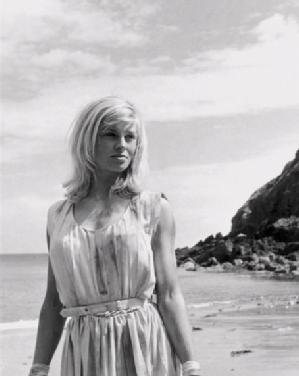 A few years later, in October 1961, the BBC aired a now-lost science fiction classic which put a different, and still-relevant, slant on the same themes. A for Andromeda involved the receipt and decipherment of an alien message from the Andromeda galaxy, leading to the construction of a pre-programmed alien supercomputer and the consequences of that construction. It was based on an idea by established Cambridge astronomer and science fiction author Fred Hoyle, which was adapted as a detailed screenplay by television scriptwriter John Elliott after a lengthy discussion. Hoyle had been inspired both by Bernard Lovell’s work at Jodrell Bank radio telescope (which rose to prominence with satellite tracking in 1957 and unexpectedly detected a strong radio source in Andromeda soon after it was first activated) and by his own interactions with colleagues and political forces as a maverick scientist who believed strongly in his own abilities.
A few years later, in October 1961, the BBC aired a now-lost science fiction classic which put a different, and still-relevant, slant on the same themes. A for Andromeda involved the receipt and decipherment of an alien message from the Andromeda galaxy, leading to the construction of a pre-programmed alien supercomputer and the consequences of that construction. It was based on an idea by established Cambridge astronomer and science fiction author Fred Hoyle, which was adapted as a detailed screenplay by television scriptwriter John Elliott after a lengthy discussion. Hoyle had been inspired both by Bernard Lovell’s work at Jodrell Bank radio telescope (which rose to prominence with satellite tracking in 1957 and unexpectedly detected a strong radio source in Andromeda soon after it was first activated) and by his own interactions with colleagues and political forces as a maverick scientist who believed strongly in his own abilities.
The original recordings of the seven part television serial were wiped from the BBC Archive, and the serial took on the status of a lost cult classic based in part on memories of those who saw it, in part on the surviving fragments and sequel (The Andromeda Breakthrough, 1962) and in part on the novelisations published a few years after the first broadcasts. In 2006, a new 90-minute production was made for BBC4, updating and modernising the story in a script written by Richard Fell.
So why am I telling you about this? Well, A for Andromeda anticipates and articulates several interesting themes which are still relevant today, and its different versions provide scope for a comparison of how those same themes have been interpreted over time.
Beyond the Blue Skies: the Military, Politics, Commercialism and Science
Most (although not all) astronomers tend to think of themselves as blue-skies scientists: doing the research for its own sake and with wider applications important but some way down the road. One thing Andromeda clearly articulates is the limitations of this mode of thought - and indeed the flaws in the blue-skies viewpoint which could be seen even 50 years ago.
Jodrell Bank, the telescope project on which the similar observatory in Andromeda is based, was used from its earliest days for tracking of cold war space hardware and, as a result, part-funded by the military (including some funding from overseas). The majority of its costs came from the UK government, but the telescope was seen as much as a prestige project as a scientific one, with the telescope providing the futuristic icon Britain needed in the post-war years. Even then, its funding was precarious, with a budget that spiralled out of its control, and its creator Lovell had to lobby hard for the resources and was prey to political whims and changes (see Agar 1998 for detailed discussion of this).
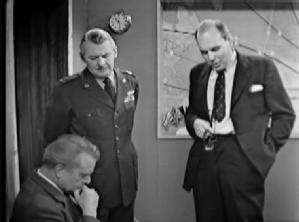 In A from Andromeda, the telescope at Bouldershaw Fell was explicitly funded for military space hardware tracking (1961) or for counter-terrorism intelligence and espionage (2006). While the sociopolitical context had shifted between the two versions, the underlying fact hadn’t: a project this large is essentially impossible to fund on scientific merit alone. Indeed, the military and political establishments are constant presences through the story, and the goals of the project are refocused (or corrupted, depending on your point of view) towards development of satellite interceptor missiles (1961) or DNA-targeted biological weapons (2006).
In A from Andromeda, the telescope at Bouldershaw Fell was explicitly funded for military space hardware tracking (1961) or for counter-terrorism intelligence and espionage (2006). While the sociopolitical context had shifted between the two versions, the underlying fact hadn’t: a project this large is essentially impossible to fund on scientific merit alone. Indeed, the military and political establishments are constant presences through the story, and the goals of the project are refocused (or corrupted, depending on your point of view) towards development of satellite interceptor missiles (1961) or DNA-targeted biological weapons (2006).
This has been a long term relationship. While most astronomers are unlikely to be in a position to manufacture alien-inspired weapons, it’s striking to see the echoes of early military-funded astronomy projects like Jodrell Bank in both fiction and today’s astronomy. Several of the large all-sky monitoring surveys such as PanSTARRS have been military-funded. This was pitched as an astronomical project to monitor for supernovae, NEOs and other transient objects. It was funded by the US defence budget primarily as a tracking device for military satellites. Similarly space domain awareness - the discipline of tracking space debris and satellite activity - is a growing research field at the current time, with both scientific and military funding underwriting the expense. This can trace its origins directly back to the pioneering work of Jodrell Bank and other telescopes which attempted to track the Sputnik satellites, but it’s not a field of the past. Given the huge increase in satellite constellations currently being launched, the threat to space-borne devices posed by uncontrolled and unmonitored space debris is now too large to ignore.
In that context, it’s interesting to note an additional theme in the 1961 version of A for Andromeda, which was cut (presumably in the interest of brevity) from the 2006 feature length version. A lingering threat in the original version, alongside military and political machinations was a multinational corporate entity - Intel - which wanted information from the project for commercial reasons of its own (note this long-preceded the creation of the more familiar modern Intel!). This corporation became the main antagonist in the sequel, The Andromeda Breakthrough. Again, today’s astronomers seldom have hugely commercialisable data, but given the rise of commercial space use and aspiration, it’s still interesting to note that the tension between research for its own sake, research for national or political goals and research for profit which was being articulated so long ago and still resonates today.
The Monstrous Mother: Dawnay as a female scientist
Scientists in A for Andromeda follow several familiar tropes. They include the young, scruffy (invariably male) maverick genius who acts as protagonists. Andromeda scientists seem to be experts in multiple quite distinct disciplines of scientific endeavour, and (at least in the 2006 version) have a tendency to wear lab coats even when sitting in an office or observatory. However one notable feature of A for Andromeda is its early appearance of a female scientist character in a senior role. In the 1961 version, Professor Madeline Dawnay is a university biochemist drafted into the project when her expertise is needed, who works alongside the senior (male) astrophysicist and computer scientists. In the 2006 version she is an astrobiologist who is in charge of the project in her own right. In both cases, she is an academic professor with expertise in biological experimentation (a bit puzzling for an astrobiologist with command of a radio observatory, but we can stretch a point in the interests of narrative).
Women are severely underrepresented in the physical sciences. Although they are perhaps a little less so in the biological sciences, it is still unusual even today for the authoritative figure representing a scientific discipline to be female in popular media. Exceptions do, of course, exist: Professor Jocelyn Peabody in Dan Dare was shown as an expert agricultural scientist as early as 1950, but she is very much the exception rather than the rule. On the BBC, science fiction viewers had been treated to the stereotypical rocket scientist Bernard Quatermass in the 1950s, and would encounter both the Doctor and school science master Ian Chesterton in Doctor Who in 1963. Ian’s female counterpart, Barbara Wright, was firmly relegated to the humanities. Indeed, the novelty of a female scientist role in Andromeda is no accident: producer Michael Hayes commented (in the Andromeda Memories documentary accompanying a 2006 DVD release of the surviving 1961-2 footage) that the character had originally been written as male and deliberately replaced with a woman actor to evoke a possible more equitable future.
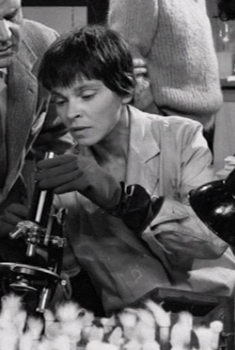 So how is Dawnay represented in A for Andromeda? Is she a potential icon and popular-culture role-model for women in science? Well, yes and no. She is shown as highly competent, assertive and (mostly) moral. There is no doubting her academic credentials, and she accomplishes an exceptional feat of biochemistry. On the other hand, she is also shown to be arrogant and “pushy” (in a way that for any of the male scientists would likely be considered strong or assertive). In 1961, actress Mary Morris was portrayed with short-cropped (masculine) hair, and she was described in the novelisations as “mannish” and “with all the charm… of a test-tube full of dried skin”. It's unlikely to be a coincidence of casting that Morris was openly lesbian - relatively rare at the time - and defied conventional stereotypes in her manner and appearance.
So how is Dawnay represented in A for Andromeda? Is she a potential icon and popular-culture role-model for women in science? Well, yes and no. She is shown as highly competent, assertive and (mostly) moral. There is no doubting her academic credentials, and she accomplishes an exceptional feat of biochemistry. On the other hand, she is also shown to be arrogant and “pushy” (in a way that for any of the male scientists would likely be considered strong or assertive). In 1961, actress Mary Morris was portrayed with short-cropped (masculine) hair, and she was described in the novelisations as “mannish” and “with all the charm… of a test-tube full of dried skin”. It's unlikely to be a coincidence of casting that Morris was openly lesbian - relatively rare at the time - and defied conventional stereotypes in her manner and appearance.
While Jane Asher wore long hair as Dawnay in the 2006 version, she also dressed in designer trouser suits wildly inappropriate for the setting and remained aloof from emotional connection with her team. It is both interesting and depressing to note that the more modern production team reported in the accompanying documentary (on the 2006 production DVD) that they had been told there were still no senior women “operating at that level”. Taking this to mean an academic professor and project leader in astrophysics or astrobiology, such an assertion is patently untrue. Either way it seems that little has changed in the way a senior woman must be presented as a scientist in the fifty year span we are considering.
So why have I referred to Dawnay as a monstrous mother? For those unfamiliar with the term, I believe it was coined by Creed (1993) in reference to female characters in horror and other aspects of popular culture who either create or nurture anything other than their natural-born human children (or instead fail to nurture their children) and thus are implicitly shown to be negligent in their biological role. This usually doesn’t end well. Examples range from the classical Medea to the modern Rani in Doctor Who. Dawnay fits firmly into this trope. In both the original A for Andromeda and its remake, it is Dawnay who creates the organism designed by the alien computer and delivers it from a tank into the wider world, continuing to nurture it thereafter. The novelisation of Andromeda describes a scene between Dawnay and military medical officer Hunter as follows:
“When I first came here, I’d never have believed….” She broke off, suddenly and unexpectedly overtaken by emotion. When she continued it was in a softer voice. “All the alchemy of making gold come true. Of making life.” She tapped the rubber tubing and resumed her usual gruff way of speaking. “We’re feeding her intravenously. You may find she’s no instinct for normal suckling. You’ll have to teach her.”
“You’ve landed us quite a job,” said Hunter, not unmoved but anxious already about formal responsibilities.
‘I’ve landed you a human life, made by human beings. It took nature two thousand million years to do a job like that: it’s taken us fourteen months.”
Hunter’s official bedside manner returned to him. “Let me be the first to congratulate you.”
“You make it sound like a normal birth,” said Dawnay, managing to sniff and smile at the same time.
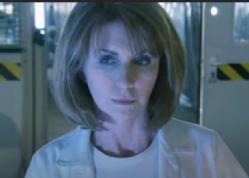 While the infant - later dubbed Andromeda - rapidly matures, Dawnay continues to be shown in a protective and educational context. This puts her firmly in a maternal role, and particularly when shown together with her “mannish” appearance and prominence in a traditionally masculine field is effectively begging for that ‘perversion’ of motherhood and a woman’s place to be recognised. This essential message was stronger in the 1960s representation but remains as an uncomfortable subtext in the 2006 adaptation where her role is essentially unchanged, and her position was still seen as remarkable by the production team. Indeed the 2006 version includes a scene which cuts between the male protagonist experiencing a sexual encounter with a female assistant and glimpses of Dawnay in a clinical laboratory declaring "We've made life!", making the dichotomy between (natural) procreation and Dawnay's (unnatural) role explicit.
While the infant - later dubbed Andromeda - rapidly matures, Dawnay continues to be shown in a protective and educational context. This puts her firmly in a maternal role, and particularly when shown together with her “mannish” appearance and prominence in a traditionally masculine field is effectively begging for that ‘perversion’ of motherhood and a woman’s place to be recognised. This essential message was stronger in the 1960s representation but remains as an uncomfortable subtext in the 2006 adaptation where her role is essentially unchanged, and her position was still seen as remarkable by the production team. Indeed the 2006 version includes a scene which cuts between the male protagonist experiencing a sexual encounter with a female assistant and glimpses of Dawnay in a clinical laboratory declaring "We've made life!", making the dichotomy between (natural) procreation and Dawnay's (unnatural) role explicit.
It’s worth mentioning that in the 1962 sequel, The Andromeda Breakthrough, it is largely Dawnay’s scientific skill that is responsible for saving the world, but nonetheless, she is not the protagonist of the story, and there’s an argument that without her the world would never have been in danger. As a role model then, Dawnay falls short in a number of respects, and while her existence in a 1960s SF is notable, it is difficult to argue that hers is a particularly positive representation.
The Alien Trojan Horse
Returning to the main theme of Andromeda though, I also wanted to highlight how little the central premise of an alien infiltration by software or information has aged. When Hoyle was imagining the plot in the early 1960s, computers were valved devices that filled a room and had less processing power than a modern microwave oven. The adaptation in 2006 rendered the computer instead as a spinning ball of lights. Both constructions are essentially implementations of Turing’s universal machine: a device for interpreting a programmed algorithm... and the danger lies in that algorithm.
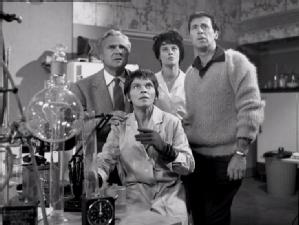 As recently as 2018, a serious scientific paper explored a thought experiment regarding the interpretation of an imagined message received by SETI monitoring. They concluded that not only would it be perfectly possible for such a message to contain a virus-like artificial intelligence with malign intent, but that it was impossible to demonstrate that it did not or “decontaminate” the message so that it could be read. They suggested that no extraterrestrial message received should ever be studied as a result.
As recently as 2018, a serious scientific paper explored a thought experiment regarding the interpretation of an imagined message received by SETI monitoring. They concluded that not only would it be perfectly possible for such a message to contain a virus-like artificial intelligence with malign intent, but that it was impossible to demonstrate that it did not or “decontaminate” the message so that it could be read. They suggested that no extraterrestrial message received should ever be studied as a result.
Nor have they been alone in this. Many thinkers have noted that alien life may be either so deliberately hostile or so innocently advanced and beyond our comprehension that our culture, civilisation and maybe species would not survive the meeting. Exploring our readiness for such an encounter and its consequences has been a major preoccupation of science fiction since the origins of the genre. But what is startling is the manner of the encounter Hoyle proposed: his recognition of the sheer power of information alone and the dangers its misuse might pose.
Given the volume and complexity of information in the world around us today, and the vast commercial and political value of big data, the risks and uncertainties regarding information misuse have come to public consciousness in a way that decontamination of alien threats might never have done.
More so than ever before then, A for Andromeda feels like it carries a lesson we should consider studying again today.
"A for Anticipation", Elizabeth Stanway, Cosmic Stories blog, 16th May 2021
